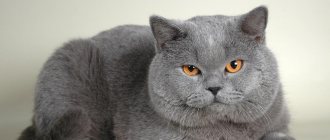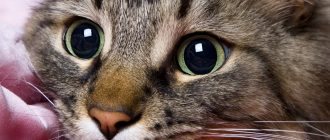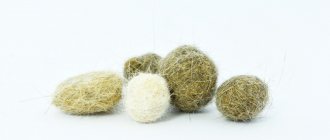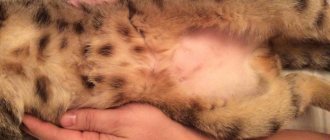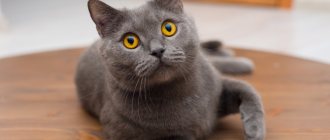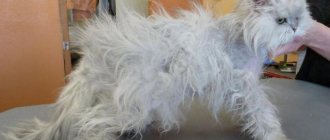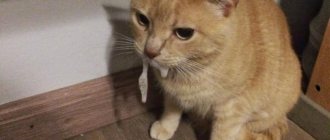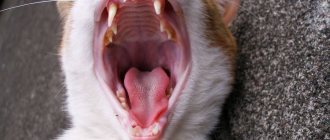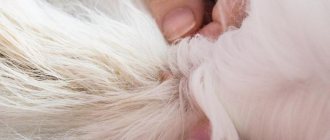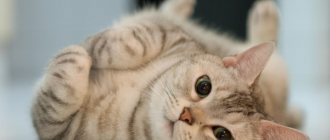In fact, cat fur is a hair coat that is a derivative of the epidermis. There are different types of fur: thin, thick, soft like down and hard like bristles, straight or curly. Despite such differences, it is important to care for long-haired and short-haired breeds regularly, otherwise the condition of the coat will worsen, in addition, the risk of developing various dermatological pathologies, which are not easy to deal with, will increase.
Types of hair in cats and description
Coat types, which are an individual feature of the breed, are classified based on the length, thickness and structure of the hairs.
In addition, the specific combination of guard hair, guard hair, and undercoat is determined. Based on this criterion, the following types of cat hair are distinguished:
- Undercoat. This is soft, fluffy fur, the main function of which is thermal insulation. It is the presence of undercoat on the body that provides the animal with reliable protection from the cold in winter and from the heat in summer. If you do not take care of the coat and comb it in a timely manner, this layer becomes tangled. The animal looks unkempt and sheds heavily. However, some breeds, such as Orientals, have no downy hair at all.
- Guard hair. Forms a middle covering layer. At the base the hair is thinner, and at the tip it thickens. The structure and size vary depending on the individual characteristics of the variety. One species has guard and guard hairs of the same length; in others, the guard may be shorter.
- Protective. It differs from other types in that it has a rigid structure that protects the animal’s body from getting wet. The hairs are wider from the base, but gradually narrow towards the tip. It is this type of cat fur that determines the main color.
- Pooh. Grows in kittens and sphinxes. The hairs are very thin, sparse, and difficult to distinguish in adult representatives.
- Vibrissae. They are long whisker hairs that take an important part in the life of the animal. Whiskers are located on both sides of the muzzle, above the eyes and on the outside of the lower leg. It is forbidden to cut off tactile hair, because without it the animal will not be able to fully receive signals from the outside world and fully communicate with its relatives.
Beautiful fur in cats: how to achieve
A fluffy cat, shining with health, is the pride of any owner. But what can you do to ensure that your fur is always attractive? We'll talk about this in our article.
3 main factors for a beautiful cat appearance:
- proper and regular care,
- balanced diet,
- suitable microclimate in the house.
In order for your pet to have a healthy coat and well-groomed appearance, you need to follow all the rules.
Content
How is color formed?
The main component of all cat colors is two basic colors: orange and black.
There are 2 main basic cat colors:
- black;
- orange or red.
It is these colors that are the main component of the various shades. Most colors are characteristic of purebred and outbred felines. However, breeders, during complex selective work, were able to ensure that only a certain variety could have a certain color, for example, pure white.
Fur length
The following types of breeds are distinguished depending on the length of the hair:
- Naked. This variety was not specially bred, and the main reason for the lack of hair is a gene mutation. If both parents are bald, the kittens that are born will also have no hair. However, there is still a small amount of fine hairs on the skin that are not able to protect the animal from the cold.
- Short-haired. This species has fur that does not exceed 5 cm in size. Despite the fact that the hair is thick, it does not require special care. It is enough to scratch the animal 1-2 times a week with a special brush to get rid of lost hairs.
- Semi-longhaired. The variety has long hair, but the undercoat is not very thick and fluffy. The difference in fur length is most noticeable in winter and summer.
- Long-haired. This beautiful fluffy breed's fur grows no less than 10-12 cm. The animal requires special, careful care so that the fur coat shines, does not become disheveled and does not become covered with tangles. In addition, animals are prone to heavy shedding, which increases the risk of hair accumulation in the digestive organs.
Main types of cat fur
For a long time, cats were classified into two types based on the length of their fur:
- short-haired, with a coat length of up to 5 cm
- long-haired, with a coat length exceeding 5 cm
Today, breeders have expanded this range by breeding new and unique cat breeds. Thus, hairless representatives of cats appeared, which can be naked or have hair not exceeding 1 cm in length.
Hairless (hairless) cat breeds
Hairless types include several interesting species:
- flock - velvety hairs, so short that they are visually difficult to distinguish, but are noticeable when stroking the animal
- brush - actually bristles, hard, sparse and broken short hairs
- velor – curly soft hairs, visually distinguishable on the animal’s body
Some breeds of hairless cats are born almost completely naked, sometimes with sparse hair on the face, paws and tail. Others are born with sparse hair, which, as a rule, falls out completely or partially before the animal is 1.5 years old.
Short-, semi- and long-haired cats
In addition to hairless breeds, modern felinologists have identified the category of semi-long-haired cats, which includes animals with a coat length of 5-10 cm. As for real long-haired breeds, these are cats with luxurious hair over 10 cm in length.
Cat fur can be:
- long
- double (guard hair and undercoat of the same length)
- semi-long with and without undercoat
- short with undercoat and without undercoat
- rigid or wire
- curly or wavy (rex)
The cat's coat performs the function of thermoregulation, protecting the animal's body from the negative effects of the environment. Closer to summer, cats shed their undercoat - they shed. The fur coat becomes lighter, which means the animal can more easily tolerate high air temperatures. In autumn the reverse process occurs. Cats grow an undercoat and pets become very fluffy. And such a fur coat is practically not afraid of cold weather. What are the features of caring for different types of cat fur?
Features of caring for hairless cats
Hairless cats require special care. Devoid of hair, these animals have very delicate skin. Unlike their furry relatives, they need more frequent water treatments. For this purpose, special cosmetics are used. For example, hypoallergenic shampoo for hairless cat breeds. To prevent dry skin, it is lubricated with a special moisturizer, light oil or high-quality baby cream, preferably hypoallergenic. In the summer, hairless cats are bathed at least once a week, and in other seasons - at least once a month. If the pet does not like water treatments, gently wipe the skin with a damp sponge. By the way, some breeders recommend wiping the body of hairless cats daily with a soft cloth soaked in warm water.
Features of caring for short-haired cats
The fur of short-haired cats has a length of no more than 5 cm. The group of short-haired breeds includes a lot of cats - Burmese, Singaporean, Bombay, Abyssinian, Bengal. However, the structure of their fur may be different. For example, the Russian Blue has a double coat that is thick and silky, while the Siamese and Oriental have a smooth coat that lies close to the body.
Short-haired felines require the least amount of grooming. To keep the coat healthy, beautiful and shiny, 1-2 brushing procedures per week are enough. Massage brushes for cats with short hair are ideal for this. During the shedding period, the number of procedures for combing the undercoat can be increased to 3-4 times a week, and a Furminator Curry Comb rubber brush can be chosen as an effective tool.
Bathe animals as they become dirty, using shampoos for cats with short hair.
Caring for semi-longhaired cats
Semi-longhaired cats have a coat length of 5-10 cm. Breeds with this type of coat include, for example, Burmese cats and Maine Coons. Typically, in winter and summer, these animals have a difference in the length of their fur.
Caring for semi-longhaired cats requires a lot of time, especially during the molting period. As a rule, the combing procedure is carried out 3-4 times a week, and during molting - daily. To comb out the undercoat, use a special brush - a slicker brush. To comb long guard hairs, use a brush or comb. If tangles have formed, you cannot do without a tangle cutter for cats.
Cosmetics for bathing semi-longhaired cats are selected with special care. In addition to shampoo that matches your coat type, you will need conditioner or balm. They will make the combing process easier and make the coat beautiful and shiny.
Caring for long-haired cats
Many people prefer long-haired cats, such as the Neva Masquerade, Persian or Himalayan. These are truly incredibly beautiful animals, but with only one “BUT”. The beauty of wool depends on the correctness, thoroughness and timeliness of caring for it, especially during the molting period. This requires a lot of time, knowledge and patience.
Caring for long-haired cats is virtually no different from caring for semi-long-haired cats. True, they are combed almost daily, regardless of the molting period. Cosmetics for long-haired cats include many products aimed at preventing tangling of the hair and unraveling the resulting tangles. Combs, brushes and other grooming tools must be selected taking into account the length of the animal’s fur.
Even the most common types of cat fur require proper, timely and high-quality care. Do not forget that the appearance of the coat is affected not only by care, but also by nutrition. If any problems arise with the animal’s fur, it begins to fade, falls out in clumps or constantly sheds – this is a reason to contact a veterinarian.
Difference from hair
All mammals, including humans, have hair on their bodies, the number and structure of which depends on their functional purpose.
The hair of animals has the ability to provide thermal insulation, which distinguishes it from humans.
When thick, thick hair grows all over the body, it is called fur. In cats, hair is called fur. Any type of hair, regardless of structure and other characteristics, grows from a follicle. In different areas, the hairs differ in structure and density. The main difference between human hair and animal hair is that the latter’s core of the hair follicle has the peculiarity of providing reliable thermal insulation. In humans, the composition of hair has the same structure, but in animals, hair consists of guard and integumentary hairs.
Natural causes
Minor hair loss occurs when hair follicles die. Their life cycle consists of 3 phases:
- anagen
– the longest and most active growth phase;
- catagen
– regression phase, accompanied by the cessation of further growth;
- telogen
– a resting phase, which involves the separation and removal of the hair follicle to the surface of the skin.
Other natural causes of hair loss in cats depend on the time of year, quality of diet, stress level, age and physiological characteristics. If the coat does not undergo major changes, and the pet’s health remains satisfactory, then nothing threatens its life and health.
Shedding in season
Seasonal molting in adult animals occurs twice a year: in autumn and spring. Before winter, the undercoat is renewed and becomes thicker to protect the cat from the upcoming frosts. By spring, it begins to fall out again, but this time it thins out, returning to its original state.
Long-haired pets may shed more heavily. These cats lose their hair in small clumps.
An abundance of dead hair can lead to excessive accumulation of hairballs in the stomach and intestines. These days, give your mustachioed pet pastes that stimulate hair removal, or feed it grass. Also, do not forget about regular brushing and add more vitamins to the diet, but only after consulting a veterinarian.
Inappropriate diet
When feeding cheap food or an unbalanced natural diet, hair loss can lead to the formation of bald patches. This occurs due to a lack of vitamins responsible for the quality of the coat.
Experiences and stress
Under severe stress, a mustachioed pet often falls into apathy and refuses to eat. Abnormal bowel movements and vomiting are also possible. To understand the root cause, try to analyze recent events. Most often, animals worry because of a change in environment, the appearance of new family members and insufficient attention from the owner.
Elderly age
Older animals become bald around the face and ears. After 8 years, all metabolic processes slow down. The period of hair growth is also reduced - this is natural and does not require drug treatment. If the skin loses its shine, you can take vitamins.
Pregnancy and lactation
Pregnant cats are not much different from people: first they bloom, and then they give all their strength to the new generation. At first, the cat's hair falls out on its stomach near the nipples. This makes it easier to access the source of milk when feeding. A more abundant loss occurs immediately after childbirth and lasts until the end of lactation. After this, the pet’s condition stabilizes.
What building?
Hair consists of 2 parts: the hair follicle, located under the skin, and the shaft. In addition, each hair consists of 3 layers:
- Cuticle. Layered on top of each other, tightly connected keratin scales that form the top layer of hair. Dry and dull hair on a cat is a consequence of damage and separation of scales.
- Cortex. It is a cortical layer consisting of dead cells. In addition, the cortex contains a pigment that determines the main color of the animal.
- Brain matter. Provides nutrition to the cuticle and cortex.
Contraindications
Even such an important and necessary procedure for a cat’s health may have contraindications.
You cannot use a furminator to comb animals if their fur does not have undercoat or has a special appearance, these include:
- Cornish Rex;
- Devon Rex;
- Turkish Angora;
- Burmese and Singapore cats;
- orientals.
In addition, it is prohibited to use combs and brushes with metal teeth, which can further damage the animal’s skin, which has scratches, scratches and abrasions, irritations and ulcers.
If there are tangles, they should be disassembled carefully. In particularly advanced cases, it is better to contact a groomer who will do it professionally.
Diseases of the coat
Causes and symptoms
If a cat’s fur coat has stopped shining and is getting into clumps, then there is a possibility of developing a disease in its body.
If the care of the cat’s fur is correct, the animal is healthy, then the fur coat is smooth, thick, and shiny. If not properly maintained, the hair can become tousled, tangled, and unattractive. Various diseases also affect the appearance of a fur coat, among which the following are common in cats:
- hormonal disorders;
- allergy;
- helminthiasis;
- fungal skin diseases;
- congenital disorders;
- weakened immunity;
- viral or bacterial infection;
- dysfunction of the sebaceous glands;
- liver diseases, in which, in addition to deterioration in the quality of the coat, the mucous membrane becomes yellow.
Other reasons:
- pregnancy;
- molt season;
- uncontrolled use of certain groups of drugs;
- stress;
- elderly age.
Symptoms of wool disease are:
Symptoms such as dandruff and itching indicate problems with the coat.
- Tarnishing and profuse hair loss.
- The hairs are constantly whipped into dense tangles and hang in icicles.
- Dandruff and inflammation appear on the skin on the right and left sides.
- Worried about itching, redness.
- Body temperature rises.
- The animal becomes lethargic and drowsy.
What to do to restore hair?
If a cat has bad fur, it is first important to find out the reasons for the deterioration of its condition. To do this, you need to show your pet to a veterinarian and provide a detailed description of the cat’s condition. After the initial examination, the doctor will give a referral for a comprehensive diagnostic examination. Once the diagnosis is made, treatment is prescribed.
In addition to using the medication prescribed by your doctor, it is important to review your pet’s diet and add vitamins and nutrients to it. Proper care of a cat's fur is also important. The animal must be bathed periodically with special means. It is useful to comb 1-2 times a week, and if shedding occurs, it is recommended to comb the coat more thoroughly and repeat the procedure daily.
How often can you bathe your pet?
The number of baths per month for cats depends on the length of the coat and the characteristics of its structure. Although the pet itself is quite clean, it cannot remove all the dirt from itself.
Photo: bathing a cat will rid the animal of dirt and old fur
Short-haired cats need to be bathed infrequently, about two to three times a month. Then apply the balm and wash it off after five to ten minutes. Such procedures help to significantly improve the quality of your pet’s coat.
Do not forget that combing is necessary after taking a bath to avoid matting of the fur coat.
It is recommended to wash semi-longhaired cats as needed. If the body becomes dirty or an unpleasant odor appears, bathe the animal using a special shampoo, conditioner and conditioner. Then dry the coat with a towel.
Long-haired cats need to be bathed a little more often than short-haired and semi-long-haired cats, about once or twice a month. You can use a special softening shampoo and lotion to make the coat silkier.
If you notice a little dirt on your cat’s coat, you don’t have to repeat the water procedure, which is unpleasant for the animal.
You can use dry wool cleaning products. A special spray, which can be purchased at most pet stores, must be sprayed onto the contaminated area and left to soak in for a few minutes. Then wet a napkin or handkerchief with water and wipe the stain.
But in the fight against greasy fur, similar to icicles, which is most often found in the neck and ears (where the cat cannot wash itself), a special powder can help.
Gently rub the product into the fur coat and leave for a few minutes. Then comb out the powder with a bristle brush.
